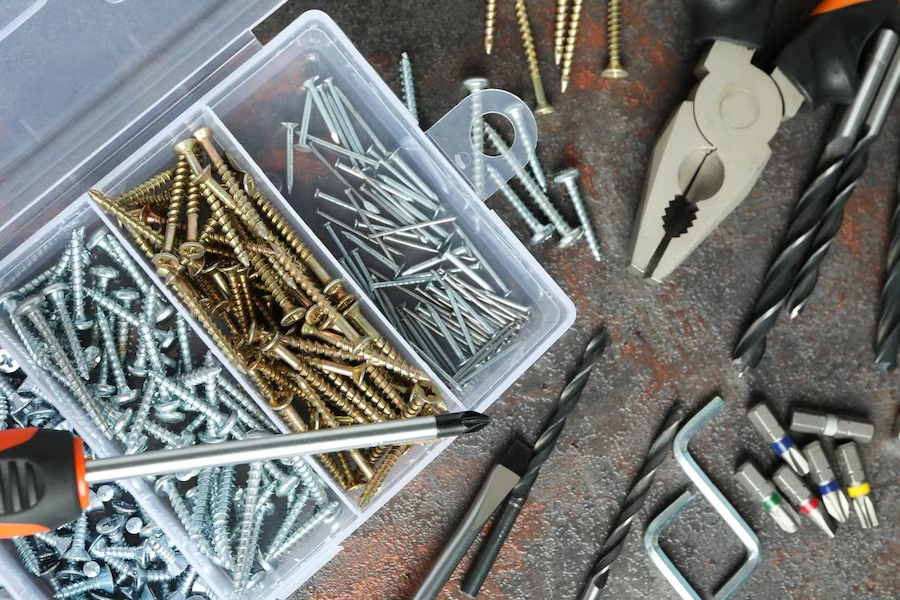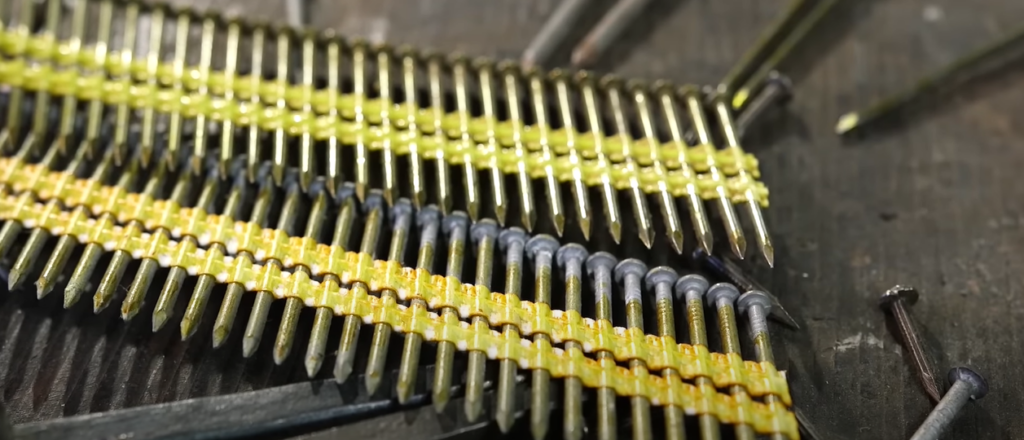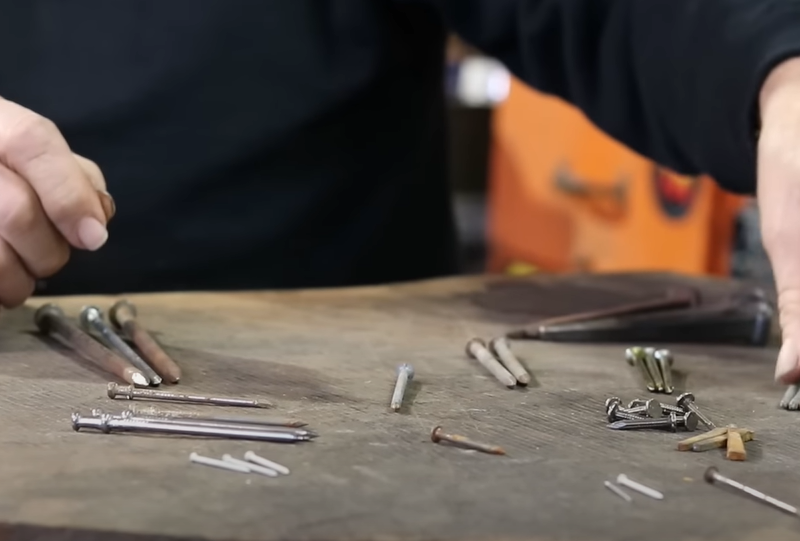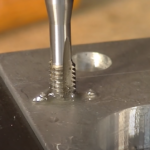A nail is an essential tool that may be used for a wide variety of construction, repair, and DIY tasks. There’s a huge range of sizes and styles available, each optimized for a particular use case. The success and longevity of any building or crafting projects greatly depend on your choice of nails. To help you choose the right nails for your project, this book provides a thorough examination of the nail hardware size chart.
The Penny System: Translating the Code
Nail sizes have traditionally been described using the penny system, represented by the letter ‘d’ for “denarius,” the Roman coin equivalent of a penny. In this technique, the length of a nail is indicated by its diameter, which might range from 2d to 60d or more.
A comprehensive chart converting coin dimensions to inches is provided below.
| Nail Size | Length (inches) |
|---|---|
| 2d | 1.00 |
| 3d | 1.25 |
| 4d | 1.50 |
| 5d | 1.75 |
| 6d | 2.00 |
| 7d | 2.25 |
| 8d | 2.50 |
| 9d | 2.75 |
| 10d | 3.00 |
| 12d | 3.25 |
| 16d | 3.50 |
| 20d | 4.00 |
| 30d | 4.50 |
| 40d | 5.00 |
| 50d | 5.50 |
| 60d | 6.00 |
Keep in mind that while the averages here should give you a good indication of what to expect, actual nail lengths can vary slightly depending on the nail type and manufacturer.
Diving into Nail Types: Form and Function

Different varieties of nails may be easily identified regardless of their length. The strength, durability, and aesthetic value added to the final product all depend on the type of nail used. Let’s take a look at every possible variety of nail, shall we?
| Nail Type | Description |
|---|---|
| Common Nails | These are the industry standard nails for use in carpentry and construction. They have a substantial body and a broad, flat top. |
| Box Nails | Box nails, which look like regular nails but are thinner, are used for more delicate building and woodworking because they prevent the board from splitting. |
| Finishing Nails | Finishing nails have small heads so they aren’t as obvious after hammered in. When a sleek, professional appearance is required, they are the material of choice for moulding and trim. |
| Brad Nails | Small, fine nails such as these are commonly used for delicate woodwork and arts and crafts. They are too small to support much weight, but they do a great job of making everything look nice and polished. |
| Roofing Nails | Roofing nails are used to fasten roofing materials such as shingles, underlayment, and felt to a roof. |
| Masonry Nails | Masonry nails, which are made of hardened steel, are used to fasten things to porous construction materials like stone, brick, or concrete. They are commonly employed in building projects when the safety of the structure is paramount. |
| Drywall Nails | The ringed or barbed shank of these nails, used for hanging drywall panels, keeps them firmly in place and stops “nail popping.” |
| Cut Nails | Cut nails are commonly utilized for flooring and cladding because of their vintage aesthetic. They can provide a more secure connection between wood fibres thanks to their rectangular cross-section. |
| Double-Head Nails | The upper head facilitates removal, while the lower head offers holding force; both are useful in temporary construction where the nails must be withdrawn. |
| Panel Pins | These finely crafted nails with their diminutive heads are ideal for delicate tasks like cabinet assembly and moulding installation. |
| Tacks | Large, flat heads on short shanks characterize tacks, often known as upholstery nails. You can use them to secure fabric or other light materials. |
| Screw Nails | The grooves in these nails help them to hold on to the board more securely. Common applications include flooring and decking. |
| Clout Nails | Clout nails, which are used for roofing and securing fabric to wood, have a short shank and a wide, flat head. |
The wide variety of nails and uses highlighted by this long list is impressive. The length and thickness of the nail aren’t the only considerations when choosing the best one for your project.
Understanding the Gauge System: Diameter Matters
Diameter is also used to categorize nails, most notably finish nails and brads. The gauge system is utilized here. A smaller nail diameter is indicated by a bigger gauge number in this system.
The diameters of popular nail gauges (in inches) are listed below for your convenience.
- 15 gauge: 0.0720 inches in diameter;
- 16 gauge: 0.0625 inches in diameter;
- 17 gauge: 0.0580 inches in diameter;
- 18 gauge: 0.0500 inches in diameter;
- 19 gauge: 0.0410 inches in diameter;
- 20 gauge: 0.0375 inches in diameter.
These sizes are, once again, estimates that can be off by a small amount depending on the nail’s material and the manufacturer.
Shedding Light on Shank Types

The section of the nail that actually penetrates the wood is called the “shank.” Different nail shanks are made for different purposes.
- Smooth Shank Nails: These nails are the most frequent type because of their durability and usefulness.
- Ring Shank Nails: In order to provide a stronger hold and prevent the nail from being pulled out, ring shank nails contain a series of rings etched into the shank. They’re typically installed on roofs and walls.
- Screw Shank Nails: These nails, which have a twisted shank and are hence resistant to withdrawal, go by another name: spiral shank nails. They find widespread use for decking and other places where tensile strength is of paramount importance.
- Barbed Shank Nails: The shank of these nails is engraved with barbs to make pulling them out even more difficult. They have a specific usage, such as supporting concrete moulds.
Deep Dive into Nail Heads
TThe section of the nail that gets hit with the hammer is called the “nail head,” and it’s flat on top. The gripping power and visibility of a nail might vary depending on the type of head.
- Flat Heads: This nail head style dominates the market. It’s big enough to keep things in place, but small enough to conceal when necessary;
- Checkered Heads: The nail heads on these nails are checkered so that the hammer won’t slip as easily;
- Cupped Heads: The tops of these heads are concave. Nail sets are necessary for driving finishing nails underneath the surface of wood;
- Countersunk Heads: These heads can be pounded below the wood’s surface, rendering them undetectable. They are frequently employed for final touches;
- Double Heads: The two heads of these nails are piled one on top of the other. The nail’s top head makes it simple to pull out of the material, but its bottom head secures it. They find widespread application as scaffolding and similar short-term building materials;
- No-Head Nails: These nails, which have either very small heads or no heads at all and are sometimes called brads, are used for finishing. Used in decorative applications when the nail head shouldn’t show.
Conclusion
Please watch this video tutorial for a more in-depth and visual explanation of nail sizes, kinds, and applications:
This practical reference is a great complement to the aforementioned guide, helping you navigate the intricate world of nail choices with ease. You’ll soon be able to confidently choose the right nail for any task, thanks to your newfound knowledge and practice.
FAQ
The ‘d’ stands for ‘denarius’, a term from the Roman Empire. It refers to a measurement system where the length of the nail is derived from the penny cost of 100 nails. However, there is not a direct correlation as a 2d nail isn’t half the length of a 4d nail.
No, nail sizes can vary based on the nail type and the manufacturer’s location. European and American manufacturers may use different standards. Always refer to specific manufacturer guidelines when selecting nail sizes.
The gauge of a nail refers to its diameter. The larger the gauge number, the smaller the diameter of the nail.
A box nail is thinner than a common nail. This makes box nails less likely to split the wood, making them better for light construction and woodworking projects.
Drywall nails or drywall screws are typically used for hanging drywall. They have a ringed or barbed shank to ensure they stay in place and reduce “nail popping.”





